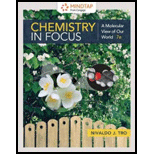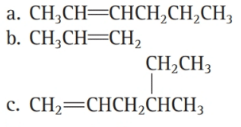
Owlv2 With Mindtap Reader, 1 Term (6 Months) Printed Access Card For Tro's Chemistry In Focus: A Molecular View Of Our World, 7th
7th Edition
ISBN: 9781337399807
Author: Tro, Nivaldo J.
Publisher: Cengage Learning
expand_more
expand_more
format_list_bulleted
Concept explainers
Textbook Question
Chapter 6, Problem 46E
Name each

Expert Solution & Answer
Trending nowThis is a popular solution!

Students have asked these similar questions
Draw the product of the reaction shown below. Ignore small byproducts that would evaporate please
Poly(ethylene adipate) is a biodegradable polyester (shown below). Identify the type of polymerization process used in the production of this polymer.
Polymers may be composed of thousands of monomers. draw two repeat units(dimer) of the polymer formed in this reaction. assume there are hydrogen atoms on the two ends of the dimer. ignore inorganic byproducts please
Chapter 6 Solutions
Owlv2 With Mindtap Reader, 1 Term (6 Months) Printed Access Card For Tro's Chemistry In Focus: A Molecular View Of Our World, 7th
Ch. 6 - Drawing Structural and Condensed Structural...Ch. 6 - Prob. 6.2YTCh. 6 - Drawing Structural Formulas for Isomers Draw...Ch. 6 - Prob. 6.4YTCh. 6 - Prob. 1SCCh. 6 - Which structure corresponds to CH2=CHCH3?Ch. 6 - Prob. 3SCCh. 6 - What property is characteristic of chlorinated...Ch. 6 - Prob. 5SCCh. 6 - Prob. 6SC
Ch. 6 - Prob. 7SCCh. 6 - Prob. 1ECh. 6 - Prob. 2ECh. 6 - Prob. 3ECh. 6 - Prob. 4ECh. 6 - What is vitalism? Why did vitalism become a...Ch. 6 - Prob. 6ECh. 6 - Prob. 7ECh. 6 - Prob. 8ECh. 6 - Prob. 9ECh. 6 - List four common fuels used by our society, and...Ch. 6 - Prob. 11ECh. 6 - Why are alkenes and alkynes called unsaturated...Ch. 6 - Prob. 13ECh. 6 - Prob. 14ECh. 6 - Prob. 15ECh. 6 - Prob. 16ECh. 6 - Prob. 17ECh. 6 - Prob. 18ECh. 6 - Prob. 19ECh. 6 - Prob. 20ECh. 6 - Prob. 21ECh. 6 - Prob. 22ECh. 6 - Prob. 23ECh. 6 - Prob. 24ECh. 6 - Prob. 25ECh. 6 - Prob. 26ECh. 6 - Prob. 27ECh. 6 - Prob. 28ECh. 6 - Prob. 29ECh. 6 - Prob. 30ECh. 6 - Prob. 31ECh. 6 - Prob. 32ECh. 6 - Prob. 33ECh. 6 - Prob. 34ECh. 6 - Prob. 35ECh. 6 - Prob. 36ECh. 6 - Prob. 37ECh. 6 - Prob. 38ECh. 6 - Prob. 39ECh. 6 - Prob. 40ECh. 6 - Prob. 41ECh. 6 - Prob. 42ECh. 6 - Naming Hydrocarbons Name each alkane:Ch. 6 - Name each alkane:Ch. 6 - Name each alkyne:Ch. 6 - Name each alkyne: a.CH3CHCHCH2CH2CH3Ch. 6 - Name each alkyne:Ch. 6 - Prob. 48ECh. 6 - Prob. 49ECh. 6 - Prob. 50ECh. 6 - Drawing Hydrocarbon Structures from Names Draw the...Ch. 6 - Draw the condensed structural formula for each...Ch. 6 - Prob. 53ECh. 6 - Prob. 54ECh. 6 - Prob. 55ECh. 6 - Prob. 56ECh. 6 - Functionalized Hydrocarbons Identify each compound...Ch. 6 - Identify each compound according to its functional...Ch. 6 - Identify each compound according to its functional...Ch. 6 - Identify each compound according to its functional...Ch. 6 - Propane, CH3CH2CH3, is a gas at room temperature,...Ch. 6 - Prob. 62ECh. 6 - What was the impact of vitalisms downfall on...Ch. 6 - Why do you think our society has mixed feelings...Ch. 6 - Prob. 65ECh. 6 - Prob. 66ECh. 6 - Prob. 67ECh. 6 - Any one molecule can be represented many ways. For...Ch. 6 - Explain why the formula CH3CH2CH3 cannot mean:...Ch. 6 - Prob. 70ECh. 6 - Prob. 71ECh. 6 - Prob. 72ECh. 6 - Prob. 73E
Knowledge Booster
Learn more about
Need a deep-dive on the concept behind this application? Look no further. Learn more about this topic, chemistry and related others by exploring similar questions and additional content below.Similar questions
- Draw the product of the reaction shown below. Use a dash or wedge bond to indicate stereochemistry of substituents on asymmetric centers, Ignore inorganic byproductsarrow_forwardDraw the product of this reaction please. Ignore inorganic byproductsarrow_forwardOne of the pi molecular orbitals of 1,3-butadiene (CH2=CHCH=CH2) is shown below. Please identify the number of nodal planes perpendicular to the bonding axisarrow_forward
- Draw the monomers required to synthesize this condensation polymer please.arrow_forwardProvide the correct systematic name for the compound shown here. Please take into account the keyboard options belowarrow_forwardcurved arrows are used to illustrate the flow of electrons. using the provided starting and product structures, draw the curved electron-pushing arrows for the following reaction or mechanistic step(s)arrow_forward
- Identify the 'cartoon' drawing of the acceptor orbital in the first mechanistic step of an electrophilic addition reaction of butadiene with HBr. Pleasearrow_forwardH- H H H H H H Identify and select all structures below that represent a constitutional isomer(s) of the compound shown above. H- H H H A. H H H H-C CI H H D. H H H H H H C C -H H C C H H H H B. H CI H H- C C H H H H E. H CI H C.arrow_forwardWhy doesn't this carry on to form a ring by deprotonating the alpha carbon and the negatively-charged carbon attacking the C=O?arrow_forward
- 6. A solution (0.0004 M) of Fe(S2CNEt2)3 (see the structural drawing below) in chloroform has absorption bands at: 350 nm (absorbance A = 2.34); 514 nm(absorbance A = 0.0532); Calculate the molar absorptivity values for these bands. Comment on their possible nature (charge transfer transitions or d-d S N- transitions?). (4 points)arrow_forwardWhat is the mechanism for this?arrow_forwardFor questions 1-4, consider the following complexes: [Co(CN)6], [COC14]², [Cr(H2O)6]²+ 4. Room temperature (20°C) measurement of molar magnetic susceptibility (Xm) for Fe(NH4)2(SO4)2×6H2O is 1.1888 x 102 cgs (Gaussian units). Calculate effective magnetic moment and provide a number of unpaired electrons for the iron ion. Use this number to rationalize the coordination geometry around iron center. (4 points)arrow_forward
arrow_back_ios
SEE MORE QUESTIONS
arrow_forward_ios
Recommended textbooks for you
 Chemistry for Today: General, Organic, and Bioche...ChemistryISBN:9781305960060Author:Spencer L. Seager, Michael R. Slabaugh, Maren S. HansenPublisher:Cengage Learning
Chemistry for Today: General, Organic, and Bioche...ChemistryISBN:9781305960060Author:Spencer L. Seager, Michael R. Slabaugh, Maren S. HansenPublisher:Cengage Learning Organic Chemistry: A Guided InquiryChemistryISBN:9780618974122Author:Andrei StraumanisPublisher:Cengage Learning
Organic Chemistry: A Guided InquiryChemistryISBN:9780618974122Author:Andrei StraumanisPublisher:Cengage Learning Organic ChemistryChemistryISBN:9781305580350Author:William H. Brown, Brent L. Iverson, Eric Anslyn, Christopher S. FootePublisher:Cengage Learning
Organic ChemistryChemistryISBN:9781305580350Author:William H. Brown, Brent L. Iverson, Eric Anslyn, Christopher S. FootePublisher:Cengage Learning Chemistry & Chemical ReactivityChemistryISBN:9781337399074Author:John C. Kotz, Paul M. Treichel, John Townsend, David TreichelPublisher:Cengage Learning
Chemistry & Chemical ReactivityChemistryISBN:9781337399074Author:John C. Kotz, Paul M. Treichel, John Townsend, David TreichelPublisher:Cengage Learning Chemistry & Chemical ReactivityChemistryISBN:9781133949640Author:John C. Kotz, Paul M. Treichel, John Townsend, David TreichelPublisher:Cengage Learning
Chemistry & Chemical ReactivityChemistryISBN:9781133949640Author:John C. Kotz, Paul M. Treichel, John Townsend, David TreichelPublisher:Cengage Learning

Chemistry for Today: General, Organic, and Bioche...
Chemistry
ISBN:9781305960060
Author:Spencer L. Seager, Michael R. Slabaugh, Maren S. Hansen
Publisher:Cengage Learning


Organic Chemistry: A Guided Inquiry
Chemistry
ISBN:9780618974122
Author:Andrei Straumanis
Publisher:Cengage Learning

Organic Chemistry
Chemistry
ISBN:9781305580350
Author:William H. Brown, Brent L. Iverson, Eric Anslyn, Christopher S. Foote
Publisher:Cengage Learning

Chemistry & Chemical Reactivity
Chemistry
ISBN:9781337399074
Author:John C. Kotz, Paul M. Treichel, John Townsend, David Treichel
Publisher:Cengage Learning

Chemistry & Chemical Reactivity
Chemistry
ISBN:9781133949640
Author:John C. Kotz, Paul M. Treichel, John Townsend, David Treichel
Publisher:Cengage Learning
Chapter 4 Alkanes and Cycloalkanes Lesson 2; Author: Linda Hanson;https://www.youtube.com/watch?v=AL_CM_Btef4;License: Standard YouTube License, CC-BY
Chapter 4 Alkanes and Cycloalkanes Lesson 1; Author: Linda Hanson;https://www.youtube.com/watch?v=PPIa6EHJMJw;License: Standard Youtube License